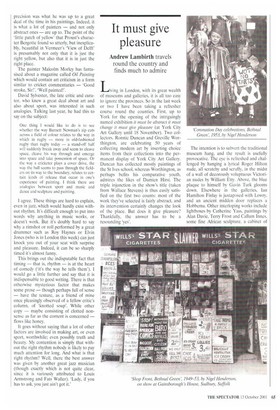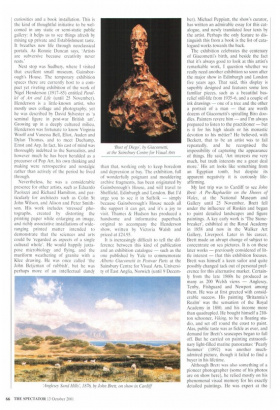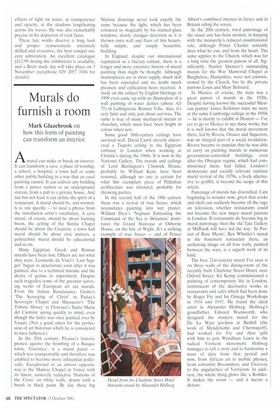It must give pleasure
Andrew Lambirth travels round the country and finds much to admire Living in London, with its great wealth of museums and galleries, it is all too easy to ignore the provinces. So in the last week or two I have been taking a refresher course round the counties. First, up to York for the opening of the intriguingly named exhibition it must be abstract it must change it must give pleasure (at York City Art Gallery until 18 November). Two collectors. Ronnie Duncan and Greville Worthington, are celebrating 50 years of collecting modern art by inserting choice items from their collections into the permanent display of York City Art Gallery, Duncan has collected mostly paintings of the St Ives school, whereas Worthington, as perhaps befits his comparative youth, admires the likes of Damien Hirst. The triple injunction in the show's title (taken from Wallace Stevens) is thus easily satisfied on the first two counts: most of the work they've selected is fairly abstract, and its intervention certainly changes the look of the place. But does it give pleasure? Thankfully, the answer has to be a resounding 'yes'.
The intention is to subvert the traditional museum hang, and the result is usefully provocative. The eye is refreshed and challenged by hanging a lyrical Roger Hilton nude, all scratchy and scruffy, in the midst of a wall of decorously voluptuous Victorian nudes by William Fay. Above, the blue plaque to himself by Gavin Turk glooms down. Elsewhere in the galleries, Ian Hamilton Finlay is juxtaposed with Lowry, and an ancient midden door replaces a Hobbema. Other interloping works include lightboxes by Catherine Yass, paintings by Alan Davie, Terry Frost and Callum Innes, some fine African sculpture, a cabinet of curiosities and a book installation. This is the kind of thoughtful initiative to be welcomed in any static or semi-static public gallery: it helps us to see things afresh by mixing up private and Establishment taste. It breathes new life through neoclassical portals. As Ronnie Duncan says, 'Artists are subversive because creativity never rests.'
Next stop was Sudbury. where I visited that excellent small museum, Gainsborough's House. The temporary exhibition spaces there are currently host to a compact yet riveting exhibition of the work of Nigel Henderson (1917-85) entitled Parallel of Art and Life (until 25 November). Henderson is a little-known artist, who mostly uses collage and photography, yet he was described by David Sylvester as 'a seminal figure in post-war British art'. Growing up in a deeply cultured milieu, Henderson was fortunate to know Virginia Woolf and Vanessa Bell, Eliot, Auden and Dylan Thomas, and to meet Duchamp, Ernst and Arp. In fact, his cast of mind was thoroughly indebted to the Surrealists, and however much he has been heralded as a precursor of Pop Art, his own thinking and making were retrospective and nostalgic rather than actively of the period he lived through.
Nevertheless, he was a considerable presence for other artists, such as Eduardo Paolozzi and Richard Hamilton, and particularly for architects such as Colin St John Wilson, and Alison and Peter Smithson. His work includes 'stressed' photographs, created by distorting the printing paper while enlarging an image, and richly associative installations of wideranging printed matter intended to demonstrate that the sciences and arts could be 'regarded as aspects of a single cultural whole'. He would happily juxtapose microbiology and flying, and the muriform weathering of granite with a Klee drawing. He was once called 'the John Betjeman of rubbish', but he was perhaps more of an intellectual dandy than that, working only to keep boredom and depression at bay. The exhibition, full of wonderfully poignant and mouldering archive fragments, has been originated by Gainsborough's House, and will travel to Sheffield, Edinburgh and London. But I'd urge you to see it in Suffolk — simply because Gainsborough's House needs all the support it can get, and it's a joy to visit. Thames & Hudson has produced a handsome and informative paperback original to accompany the Henderson show, written by Victoria Walsh and priced at £24.95.
It is increasingly difficult to tell the difference between this kind of publication and an exhibition catalogue — such as the one published by Yale to commemorate Alberto Giacornetti in Postwar Paris at the Sainsbury Centre for Visual Arts, University of East Anglia. Norwich (until 9 Decem her). Michael Peppiatt, the show's curator, has written an admirable essay for this catalogue, and newly translated four texts by the artist. Perhaps the only feature to distinguish this from a book is the list of catalogued works towards the back.
The exhibition celebrates the centenary of Giacometti's birth, and beside the fact that it's always good to look at this artist's remarkable work, I question whether we really need another exhibition so soon after the major show in Edinburgh and London five years ago. That said, this display is superbly designed and features some less familiar pieces, such as a beautiful basrelief still-life from 1935-6, and a couple of ink drawings — one of a tree and the other a portrait of a man — that are worth dozens of Giacometti's spiralling Biro doodles. Painters revere him — and I'm always prepared to listen to the practitioner — but is it for his high ideals or his monastic devotion to his metier? He believed, with Beckett, that to be an artist was to fail repeatedly, and he recognised the impossibility of capturing the appearance of things. He said, 'Art interests me very much, but truth interests me a great deal more.' His art looks like something from an Egyptian tomb, but despite its apparent negativity it is curiously lifeaffirming.
My last trip was to Cardiff to see John Brett: A Pre-Raphaelite on the Shores of Wales, at the National Museum and Gallery until 25 November. Brett fell under the influence of Ruskin and began to paint detailed landscapes and figure paintings. A key early work is 'The Stonebreaker', exhibited at the Royal Academy in 1858 and now in the Walker Art Gallery, Liverpool. Later in his career, Brett made an abrupt change of subject to concentrate on sea pictures. It is on these later works — previously considered of little interest — that this exhibition focuses. Brett was himself a keen sailor and quite possibly changed tack out of personal preference for this alternative market. Certainly from the late 1860s he produced as many as 200 Welsh views — Anglesey, Tenby, Fishguard and Newport among them. He was at first greeted with considerable success. His painting 'Britannia's Realm' was the sensation of the Royal Academy in 1880, and his income more than quadrupled. He bought himself a 210ton schooner, Viking, to be a floating studio, and set off round the coast to paint. Alas, public taste was as fickle as ever, and demand for Brett's seascapes began to fall off. But he carried on painting extraordinary light-filled marine panoramas: 'Pearly Summer' (1892) was another muchadmired picture, though it failed to find a buyer in his lifetime.
Although Brett was also something of a pioneer photographer (some of his photos are on show here), he relied mostly on his phenomenal visual memory for his exactly detailed paintings. He was expert at the
effects of light on water, at transparence and opacity. at the shadows lengthening across the waves, He was also remarkably precise in his depiction of rock faces.
These late works deserve a long look and proper reassessment: extremely skilled and evocative, the best compel sincere admiration. An excellent catalogue (fl2.99 during the exhibition) is available, and a Brett study day will take place on 3 November (telephone 029 2057 3104 for details).




























































































 Previous page
Previous page